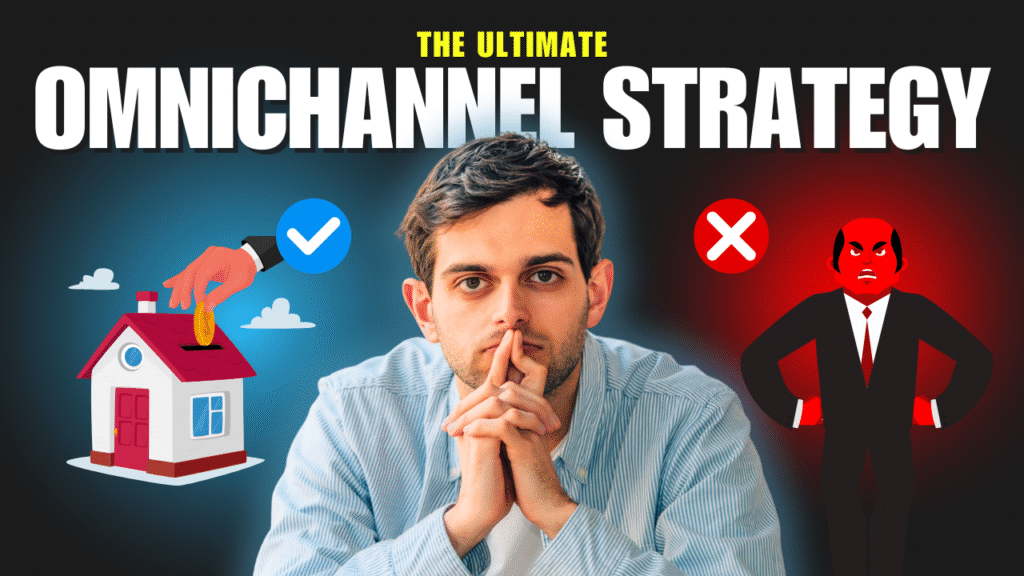Imagine this — a customer sees your Instagram ad for a summer appliance, clicks through to your website, adds it to cart but doesn’t purchase. Later, they receive a personalized WhatsApp message reminding them of the item, followed by an in-store experience that already knows what they were browsing. They feel understood. Seen. Cared for.

That’s not a lucky fluke — that’s winning with omnichannel campaigns. And in 2025, this isn’t just a trend. It’s the blueprint for success.
In this blog, we’ll explore:
- What is omnichannel marketing
- How an omnichannel strategy in 2025 works
- How to structure omnichannel campaigns
- And finally, how brands can actually win with this approach
So, Let’s Start Exploring,
What is Omnichannel Marketing?
Omnichannel means being everywhere your customer is — but with one continuous experience.
It’s not about blasting the same content on every platform. Instead, it’s about creating a connected journey across physical stores, websites, apps, social media, email, SMS, and even call centers.
In short: Omnichannel is when a customer can switch between platforms without losing context — and still feel like the brand is listening.
Difference Between Multichannel and Omnichannel?
- Multichannel = Presence on multiple platforms (Instagram, Website, Store)
- Omnichannel = All those platforms talk to each other, creating one smooth experience
If you’re only present everywhere, that’s multichannel.
If you’re connected everywhere — that’s omnichannel.
How an Omnichannel Strategy Works in 2025
The heart of any omnichannel strategy in 2025 lies in data unification and real-time personalization.
Let’s break it down step by step:
1. Collect Unified Customer Data
Customer behavior is tracked across:
- Website activity
- In-store purchases
- App usage
- Social media interactions
- WhatsApp chats
- Email opens and clicks
All this gets fed into a centralized customer database or CRM.
2. Analyze and Segment Your Audience
Now that you know who’s doing what, you can segment:
- Frequent buyers
- Cart abandoners
- In-store browsers
- High-value customers
This helps you create targeted messaging, not generic blasts.
3. Personalize Content Across Channels
Here’s where magic happens.
Example:
- They view a red AC on your website →
- Instagram shows a red-themed “cool summer” reel →
- WhatsApp sends a real-time offer →
- Email drops in with a “Complete your purchase” link
This coordinated flow of personalized nudges increases conversion without annoying the user.
4. Seamless Channel Switching
In 2025, people don’t shop linearly.
They browse at work on desktop → check later on mobile → visit the store → message on WhatsApp.
A strong omnichannel strategy ensures they don’t have to restart at each step. Every touchpoint already knows where they left off.
5. Real-Time Feedback and Support
Whether it’s:
- Chatbots answering queries
- Call center staff referencing their previous chats
- Insta DMs solving delivery questions
Everything is connected, reducing frustration and increasing brand trust.
How Omnichannel Campaigns Work
Now that we know how the system functions, let’s zoom into campaigns — the front-facing execution.
Step 1: One Message, Many Mediums
Let’s say you’re launching a campaign for your summer appliance collection.
Your omnichannel campaign could look like this:
- Instagram Reel: “Beat the heat in style”
- WhatsApp Broadcast: “Your personalized summer appliance list is ready”
- Email: “Still thinking about that cooler? Here’s 10% off”
- In-store signage: QR codes to check stock or watch product videos
- SMS: “Free installation on ACs this week only!”
Each touchpoint supports and amplifies the same goal, but speaks in the language of that platform.
Step 2: Automate the Journey
Using platforms like:
…you can map out entire customer journeys.
Example Journey:
- Visit website → sees cooler
- Doesn’t buy → gets WhatsApp offer
- Visits store → salesperson knows what they browsed
- Buys → gets email with maintenance tips
That’s a well-oiled omnichannel campaign.
Step 3: Measure, Learn, Optimize
Track:
- Which channels convert the best?
- What time do they respond?
- Did they drop off at email? Or post WhatsApp?
A good omnichannel strategy in 2025 constantly adapts. The better your data, the sharper your campaigns get.
How to Actually WIN with Omnichannel Campaigns
Let’s talk real outcomes. Here’s how omnichannel helps you win:
1. Higher Conversions
Customers are more likely to convert when:
- The messaging is consistent
- Their journey is uninterrupted
- Their needs are remembered
In fact, brands using omnichannel see up to 3x higher engagement rates than single-channel campaigns.
2. More Loyal Customers
When people feel like your brand “gets them,” they come back. Omnichannel builds:
- Emotional loyalty (you understand me)
- Convenience loyalty (you’re always accessible)
- Value loyalty (you respect my time and journey)
3. Better ROI Across the Funnel
Because data and channels are unified, your ad spend is more efficient.
Instead of cold-targeting, you’re nurturing warm leads intelligently — across multiple touchpoints.
4. Brand Consistency
Omnichannel keeps your brand tone, values, and experience cohesive everywhere — whether someone walks into your store or scrolls past your ad on Facebook.
5. Real-Time Problem Solving
Live support, automated follow-ups, instant updates — customers no longer wait hours or days for help. And a fast solution = a happy buyer.
Future of Omnichannel Strategy in 2025 and Beyond
The omnichannel strategy in 2025 is more than just smart — it’s expected.
As AI becomes better at personalization, and tools integrate even deeper, expect:
- Voice search and voice commerce touchpoints
- AR-assisted online to offline journeys
- Hyper-local WhatsApp support
- Loyalty programs synced across all platforms
Final Thoughts: Don’t Just Be Present, Be Connected
In a market flooded with noise, winning with omnichannel campaigns means you’re not just shouting across multiple platforms — you’re listening, understanding, and responding in a unified voice.
If you want to stay relevant in 2025, omnichannel isn’t optional anymore — it’s your most powerful tool.Build journeys, not just ads. Build conversations, not just broadcasts.
That’s how you win.
